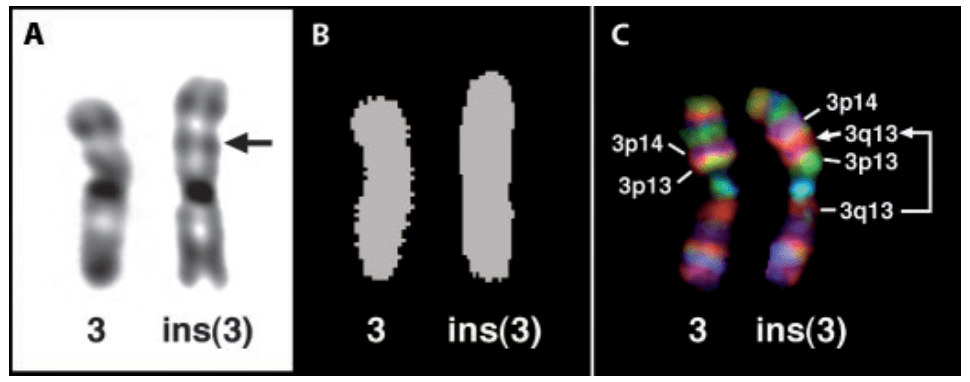Chromosomal Aberration Analysis
Multicolor Chromosome Banding (MCB)
Molecular cytogenetics methods have now become a standard method for accurately characterizing simple, complex, and secret chromosomal aberrations in the human genome, especially the FISH banding method. According to reports, multicolor chromosome band (MCB) is a powerful tool for characterizing various human marker chromosomes in molecular cytogenetics. FISH banding technology provides the possibility to simultaneously characterize several chromosomal subregions smaller than the chromosome arm. FISH banding technology is DNA-specific, with richer colors and a larger amount of characterizable information. At present, the most commonly used FISH banding technique is the multicolor banding (MCB/m-band) method, which is based on a microdissection library of a specific region, which can produce a constantly changing fluorescence intensity ratio along the chromosome. A multi-MCB probe set that can be used for comprehensive karyotype analysis of human chromosomes has been successfully constructed. It is a single probe set that combines the available region-specific microdissection derived libraries of all human chromosomes. This probe set construction method can realize the rapid analysis (single test) of karyotypes with highly complex chromosomal changes. In addition, SCAN, as a new multicolor banding technology based on the spectral karyotyping (SKY) method, can overcome the limitation of only identifying the source of abnormal fragments in chromosomes to a certain extent. Our platform provides a FISH banding analysis service for chromosome rearrangement analysis.
 Fig 1. Analysis of an intrachromosomal aberration. (, et al. 201)
Fig 1. Analysis of an intrachromosomal aberration. (, et al. 201)
MCB/m-band or SCAN Technology Services
Our platform can provide chromosome rearrangement identification services based on MCB/m-band or SCAN methods. These services are carried out based on a set of species-specific chromosome probes customized based on specific dye cutting technology. The basic process includes the use of microdissection technology to cut out and collect the same region as a specific band from the chromosome. Then the genomic DNA is extracted and purified, used as a template for degenerate oligonucleotide primer PCR (DOP-PCR), and directly labeled with a fluorescent dye. These amplified fragments as chromosome band-specific staining probes for FISH. Use one or two different fluorescent dyes (such as rhodamine, FITC, Cy5.5, and Cy5) to label each band covering a given chromosome and band-specific genomic DNA with different label combinations. Our platform includes an independent chromosome cutting laboratory, which can complete high-quality chromosome cutting and probe customization. At present, this service is mainly for human chromosome rearrangement analysis. For other types of samples or types of intrachromosomal aberration, please consult our experts. Our technical team will provide technical support from sampling to help customers further improve the quality of experimental results.
Service Features
- Our team is gradually improving the chromosome microdissection derivative libraries of commonly used species and generating specific MCB probe sets for corresponding species.
- Our independent microdissection technology operation room and equipment platform can guarantee the quality of technical services to the greatest extent.
- Our custom probes have a series of quality control and verification steps to provide you with high-quality images.
 Fig 2. Features of FISH strip testing service.
Fig 2. Features of FISH strip testing service.
Creative Bioarray provides FISH band analysis services based on chromosome microdissection to help customers carry out intra-chromosomal aberration tests. Through our customized probe set, you will gain more knowledge of chromosome changes. If you are interested in our FISH banding service, please contact us for cooperation. We look forward to cooperating with you in the near future.
References
- Liehr T, Weise A, Hinreiner S, et al. Characterization of chromosomal rearrangements using multicolor-banding (MCB/m-band)[M]//Fluorescence in situ Hybridization (FISH). Humana Press, Totowa, NJ, 2010: 231-238.
- Kakazu N, Abe T. Multicolor banding technique, spectral color banding (SCAN): new development and applications[J]. Cytogenetic and genome research, 2006, 114(3-4): 250-256.
All products and services on this website are only suitable for non-medical purposes.


 Fig 1. Analysis of an intrachromosomal aberration. (, et al. 201)
Fig 1. Analysis of an intrachromosomal aberration. (, et al. 201) Fig 2. Features of FISH strip testing service.
Fig 2. Features of FISH strip testing service.


